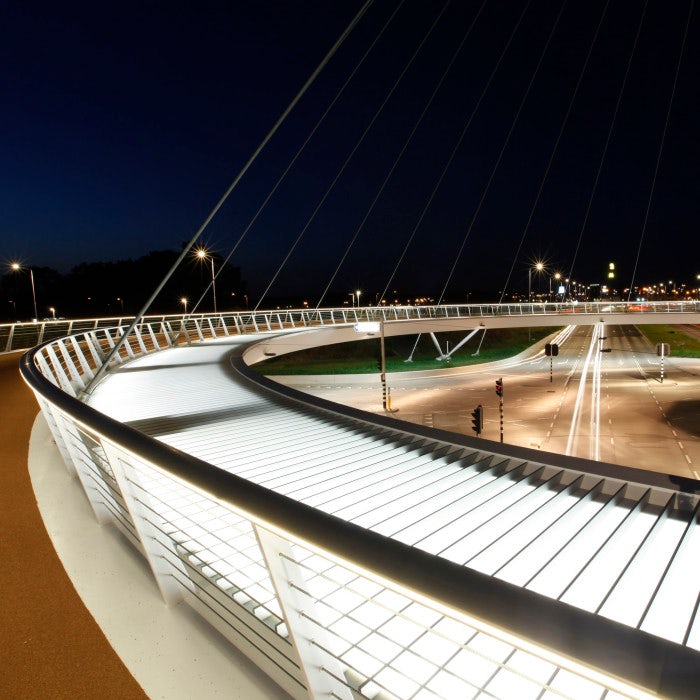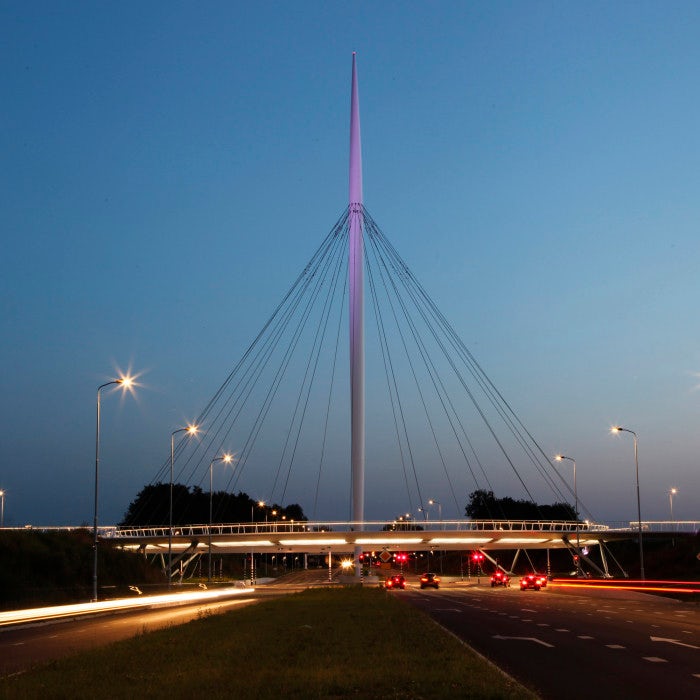Roundabouts have long since been associated with the European driving experience. More recently, these circular one-way road junctions are being used not only to help traffic flow efficiently without the need for signals, but also as a platform for new urban interventions that connect pedestrian, bicycle, and car traffic. From multi-colored glass pavilions to football stadiums, the roundabouts in this collection frame new urban centerpieces that engage the community in pleasantly unexpected ways. Prepare to circle these traffic island treasures …

© john kormeling
The Rotating House by john kormeling, Tilburg, Netherlands
Located on the Hasselt roundabout, a house not fit for human habitation rotates on the roundabout in the direction of the traffic and completes one full circle in 20 hours. The full scale model is intended to provide drivers waiting at the roundabout with a feeling of alienation from reality.



Hovenring Bicycle Roundabout by ipv Delft, Eindhoven, Netherlands
Floating above a busy multi-lane highway in Eindhoven, this steel tensioned deck protects cyclists from the complicated four-way traffic junction below. In the center of the roundabout for just cyclists, stands a 70-meter-high pylon with 24 steel cables connecting all the pieces, creating a “flying saucer” effect.

© OFIS architects

© OFIS architects

© OFIS architects
Football Stadium Arena Borisov by OFIS architects, Barysaŭ, Belarus
Located in a “peripheral roundabout,” the football stadium’s design maintained as many of the existing trees as possible within its limits. Distinguished by a bulbous, perforated ring form, the site accommodates a total of 13,000 seats, and is the new home for the local team FC bate.

© René de Wit

© René de Wit

© René de Wit
CMY Pavilion by Shift A+U, Groningen, Netherlands
The CMY pavilion mixes colors by applying translucent films in cyan, magenta, and yellow into the glass, turning it into a 3D graphic piece that changes continuously with the movement of the spectator. At different angles the CMY pavilion is experienced differently: those circulating on the roundabout via vehicle experience continuously changing colors and patterns, while pedestrians facing its long side perceive a cross-hatch pattern in six colors (CMYRGB).

© Publicshape

© Publicshape
Adventures Park Roundabout by Arquitectura, Planeamento e Design Lda., Amadora, Portugal
Illuminated in blue, green, and red, the sinuous shape of this project is an allusion to Falagueira’s river, which previously flowed in this same place, and now runs under the fountain. The three different tonalities of pebble become a dynamic representation of the undulating water flowing in the slipway.

© Alex Gaultier

© Alex Gaultier
PLAZA RICARD VIÑES by Miralles Tagliabue EMBT, Lleida, Spain
This open green space in the heart of Lleida pivots around a sculpture dedicated to the musician Ricard Viñe. Bands of planting and brick paving generate a circulation route through which pedestrians can flow, constructing a path that encourages multiple vantage points of the site.

© Studio Makkink & Bey

© Studio Makkink & Bey

© Studio Makkink & Bey
Wonderryck Pavilions by Studio Makkink & Bey, Dinkelland, Netherlands
Part of the Provincial Museum of Natural History Natura Docet in the eastern region of the Netherlands, this project is one of three wooden pavilions in the new landscape garden for Wonderryck. Standing on a roundabout, this “indoor biotope” has the form of a man-made house, but is in fact intended for animals and plants only; as such, beams block the doorway keeping humans out.




